Product and Service Innovation at Huawei: A Detailed Analysis Report
VerifiedAdded on 2023/03/17
|17
|3057
|43
Report
AI Summary
This report provides a comprehensive analysis of Huawei's product and service innovation strategies. It delves into the new product development process, examining key aspects such as idea generation, pricing, and technological advancements. The report highlights Huawei's competitive pricing strategies, including its use of competitive pricing and bundle pricing. It also explores the company's focus on technological advancements, emphasizing intelligent computing, fully-connected networks, and innovation in devices. Furthermore, the report discusses Huawei's marketing strategies, emphasizing the importance of target market diversification and strengthening touchpoints. The report also assesses the competitive landscape, including direct, indirect, and phantom competitors, and analyzes Huawei's strengths, such as its distribution channels, financial position, and skilled workforce, as well as its weaknesses, such as lower R&D spending and employee turnover. Finally, the report offers recommendations to maintain future operations, including the development of efficient R&D facilities and reducing staff turnover.
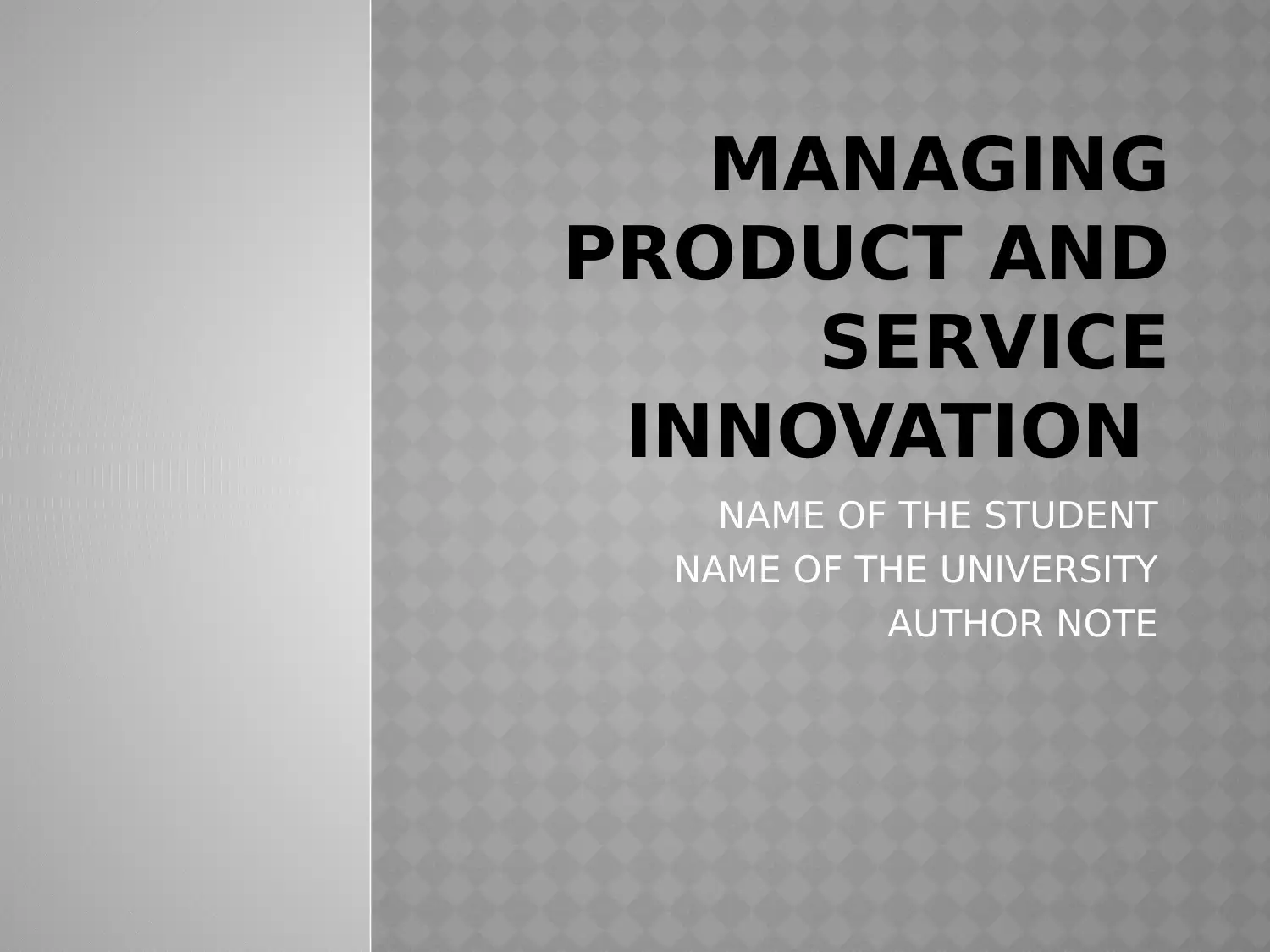
MANAGING
PRODUCT AND
SERVICE
INNOVATION
NAME OF THE STUDENT
NAME OF THE UNIVERSITY
AUTHOR NOTE
PRODUCT AND
SERVICE
INNOVATION
NAME OF THE STUDENT
NAME OF THE UNIVERSITY
AUTHOR NOTE
Secure Best Marks with AI Grader
Need help grading? Try our AI Grader for instant feedback on your assignments.
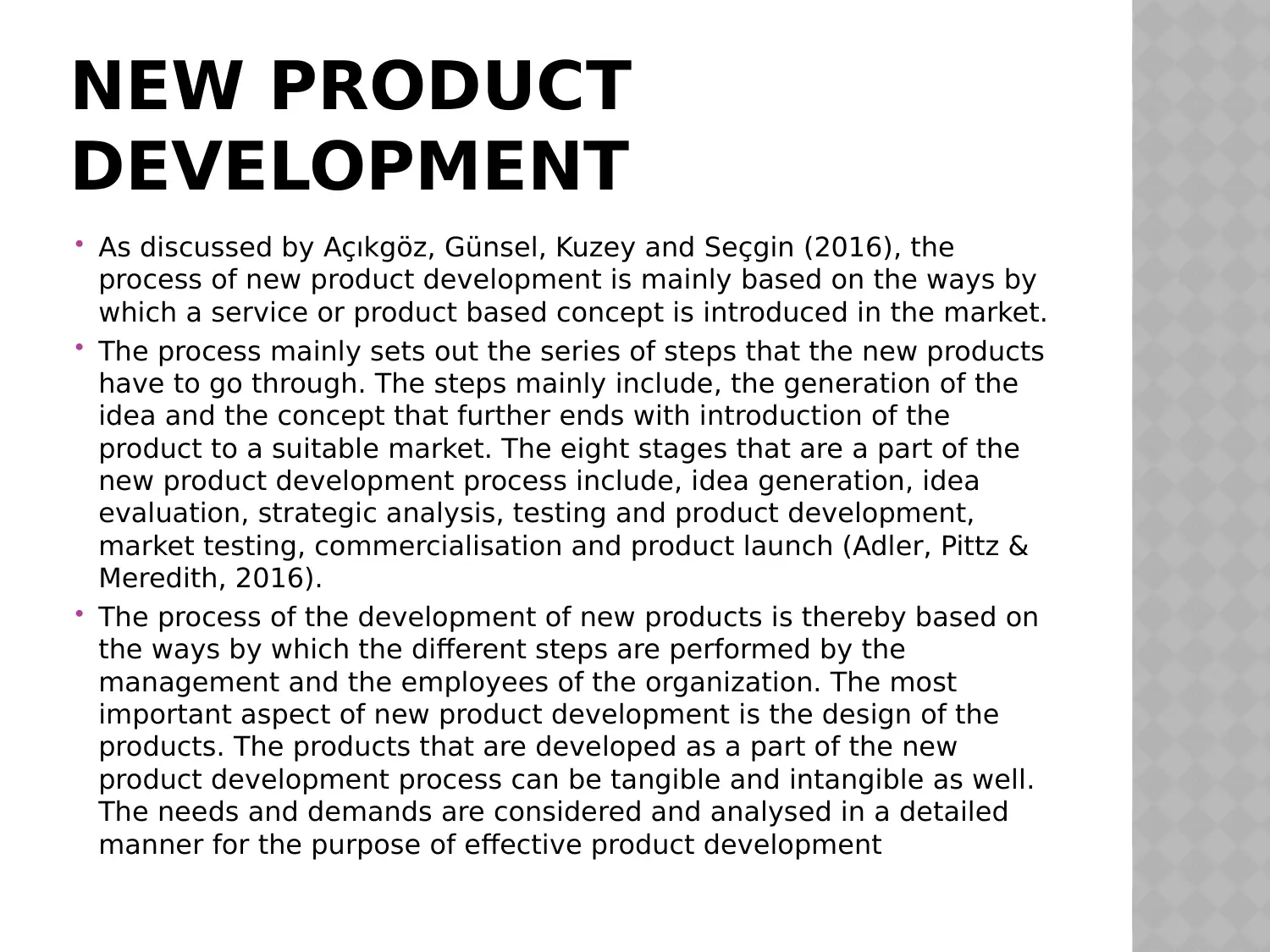
NEW PRODUCT
DEVELOPMENT
As discussed by Açıkgöz, Günsel, Kuzey and Seçgin (2016), the
process of new product development is mainly based on the ways by
which a service or product based concept is introduced in the market.
The process mainly sets out the series of steps that the new products
have to go through. The steps mainly include, the generation of the
idea and the concept that further ends with introduction of the
product to a suitable market. The eight stages that are a part of the
new product development process include, idea generation, idea
evaluation, strategic analysis, testing and product development,
market testing, commercialisation and product launch (Adler, Pittz &
Meredith, 2016).
The process of the development of new products is thereby based on
the ways by which the different steps are performed by the
management and the employees of the organization. The most
important aspect of new product development is the design of the
products. The products that are developed as a part of the new
product development process can be tangible and intangible as well.
The needs and demands are considered and analysed in a detailed
manner for the purpose of effective product development
DEVELOPMENT
As discussed by Açıkgöz, Günsel, Kuzey and Seçgin (2016), the
process of new product development is mainly based on the ways by
which a service or product based concept is introduced in the market.
The process mainly sets out the series of steps that the new products
have to go through. The steps mainly include, the generation of the
idea and the concept that further ends with introduction of the
product to a suitable market. The eight stages that are a part of the
new product development process include, idea generation, idea
evaluation, strategic analysis, testing and product development,
market testing, commercialisation and product launch (Adler, Pittz &
Meredith, 2016).
The process of the development of new products is thereby based on
the ways by which the different steps are performed by the
management and the employees of the organization. The most
important aspect of new product development is the design of the
products. The products that are developed as a part of the new
product development process can be tangible and intangible as well.
The needs and demands are considered and analysed in a detailed
manner for the purpose of effective product development
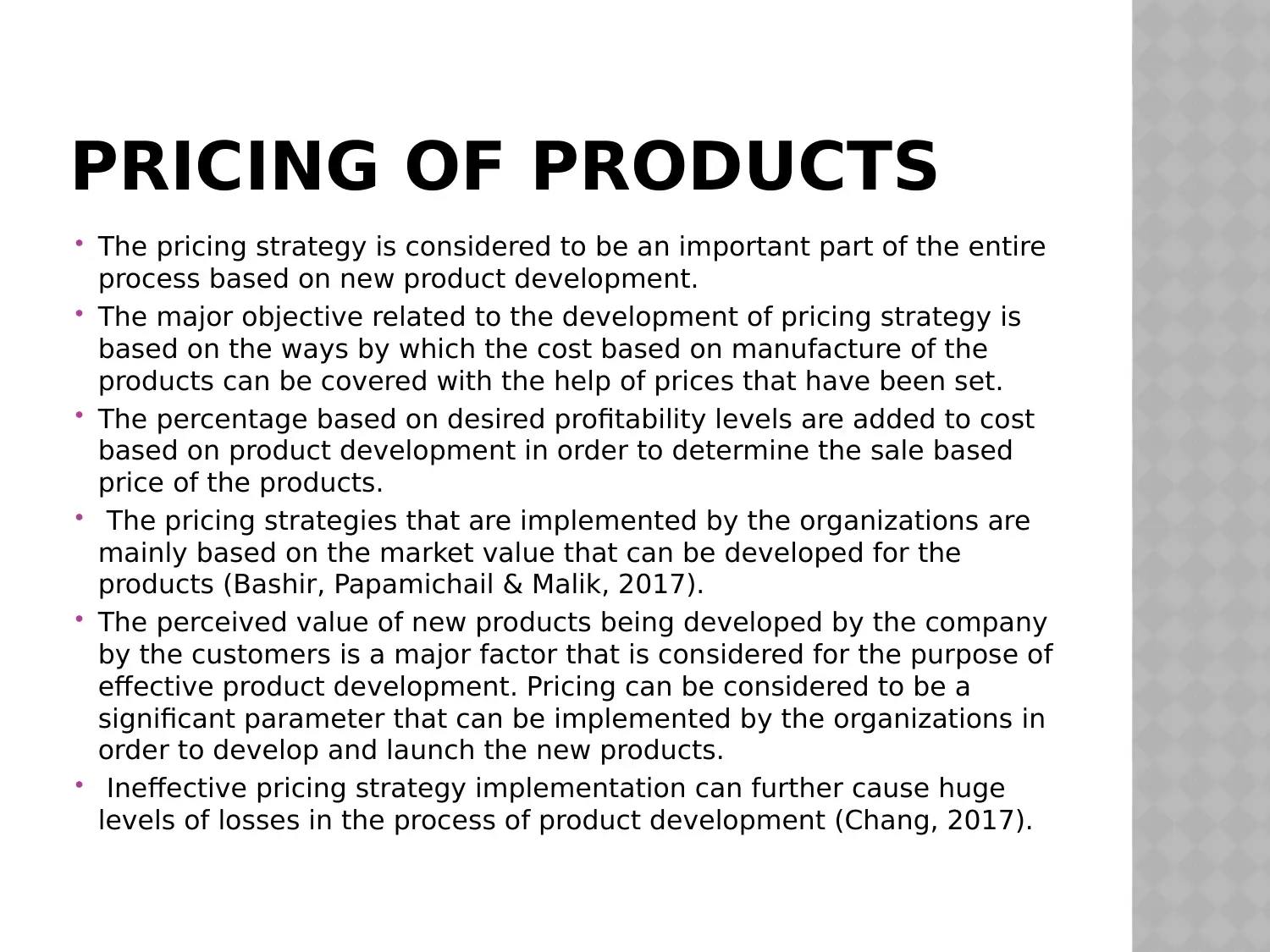
PRICING OF PRODUCTS
The pricing strategy is considered to be an important part of the entire
process based on new product development.
The major objective related to the development of pricing strategy is
based on the ways by which the cost based on manufacture of the
products can be covered with the help of prices that have been set.
The percentage based on desired profitability levels are added to cost
based on product development in order to determine the sale based
price of the products.
The pricing strategies that are implemented by the organizations are
mainly based on the market value that can be developed for the
products (Bashir, Papamichail & Malik, 2017).
The perceived value of new products being developed by the company
by the customers is a major factor that is considered for the purpose of
effective product development. Pricing can be considered to be a
significant parameter that can be implemented by the organizations in
order to develop and launch the new products.
Ineffective pricing strategy implementation can further cause huge
levels of losses in the process of product development (Chang, 2017).
The pricing strategy is considered to be an important part of the entire
process based on new product development.
The major objective related to the development of pricing strategy is
based on the ways by which the cost based on manufacture of the
products can be covered with the help of prices that have been set.
The percentage based on desired profitability levels are added to cost
based on product development in order to determine the sale based
price of the products.
The pricing strategies that are implemented by the organizations are
mainly based on the market value that can be developed for the
products (Bashir, Papamichail & Malik, 2017).
The perceived value of new products being developed by the company
by the customers is a major factor that is considered for the purpose of
effective product development. Pricing can be considered to be a
significant parameter that can be implemented by the organizations in
order to develop and launch the new products.
Ineffective pricing strategy implementation can further cause huge
levels of losses in the process of product development (Chang, 2017).
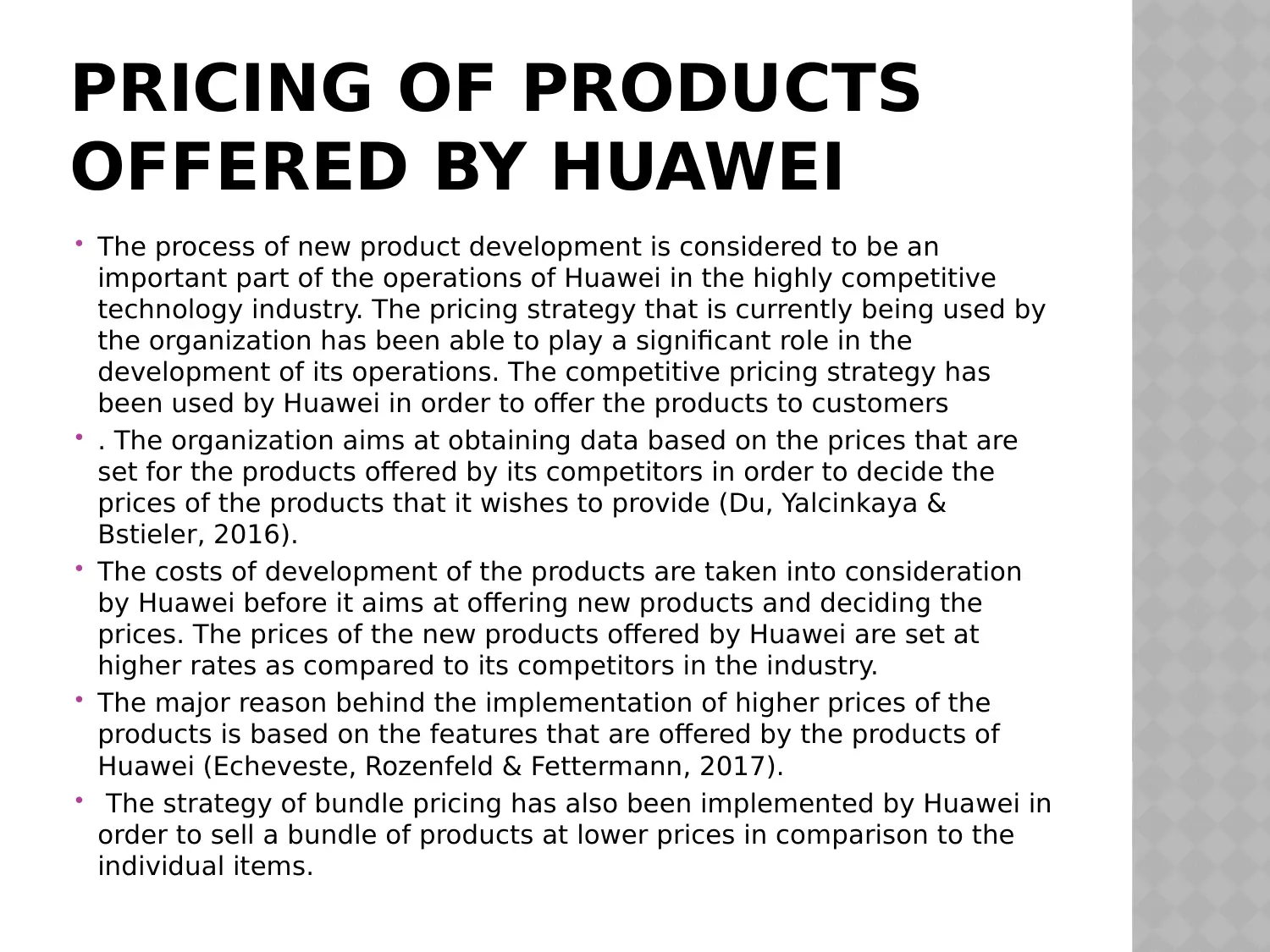
PRICING OF PRODUCTS
OFFERED BY HUAWEI
The process of new product development is considered to be an
important part of the operations of Huawei in the highly competitive
technology industry. The pricing strategy that is currently being used by
the organization has been able to play a significant role in the
development of its operations. The competitive pricing strategy has
been used by Huawei in order to offer the products to customers
. The organization aims at obtaining data based on the prices that are
set for the products offered by its competitors in order to decide the
prices of the products that it wishes to provide (Du, Yalcinkaya &
Bstieler, 2016).
The costs of development of the products are taken into consideration
by Huawei before it aims at offering new products and deciding the
prices. The prices of the new products offered by Huawei are set at
higher rates as compared to its competitors in the industry.
The major reason behind the implementation of higher prices of the
products is based on the features that are offered by the products of
Huawei (Echeveste, Rozenfeld & Fettermann, 2017).
The strategy of bundle pricing has also been implemented by Huawei in
order to sell a bundle of products at lower prices in comparison to the
individual items.
OFFERED BY HUAWEI
The process of new product development is considered to be an
important part of the operations of Huawei in the highly competitive
technology industry. The pricing strategy that is currently being used by
the organization has been able to play a significant role in the
development of its operations. The competitive pricing strategy has
been used by Huawei in order to offer the products to customers
. The organization aims at obtaining data based on the prices that are
set for the products offered by its competitors in order to decide the
prices of the products that it wishes to provide (Du, Yalcinkaya &
Bstieler, 2016).
The costs of development of the products are taken into consideration
by Huawei before it aims at offering new products and deciding the
prices. The prices of the new products offered by Huawei are set at
higher rates as compared to its competitors in the industry.
The major reason behind the implementation of higher prices of the
products is based on the features that are offered by the products of
Huawei (Echeveste, Rozenfeld & Fettermann, 2017).
The strategy of bundle pricing has also been implemented by Huawei in
order to sell a bundle of products at lower prices in comparison to the
individual items.
Secure Best Marks with AI Grader
Need help grading? Try our AI Grader for instant feedback on your assignments.
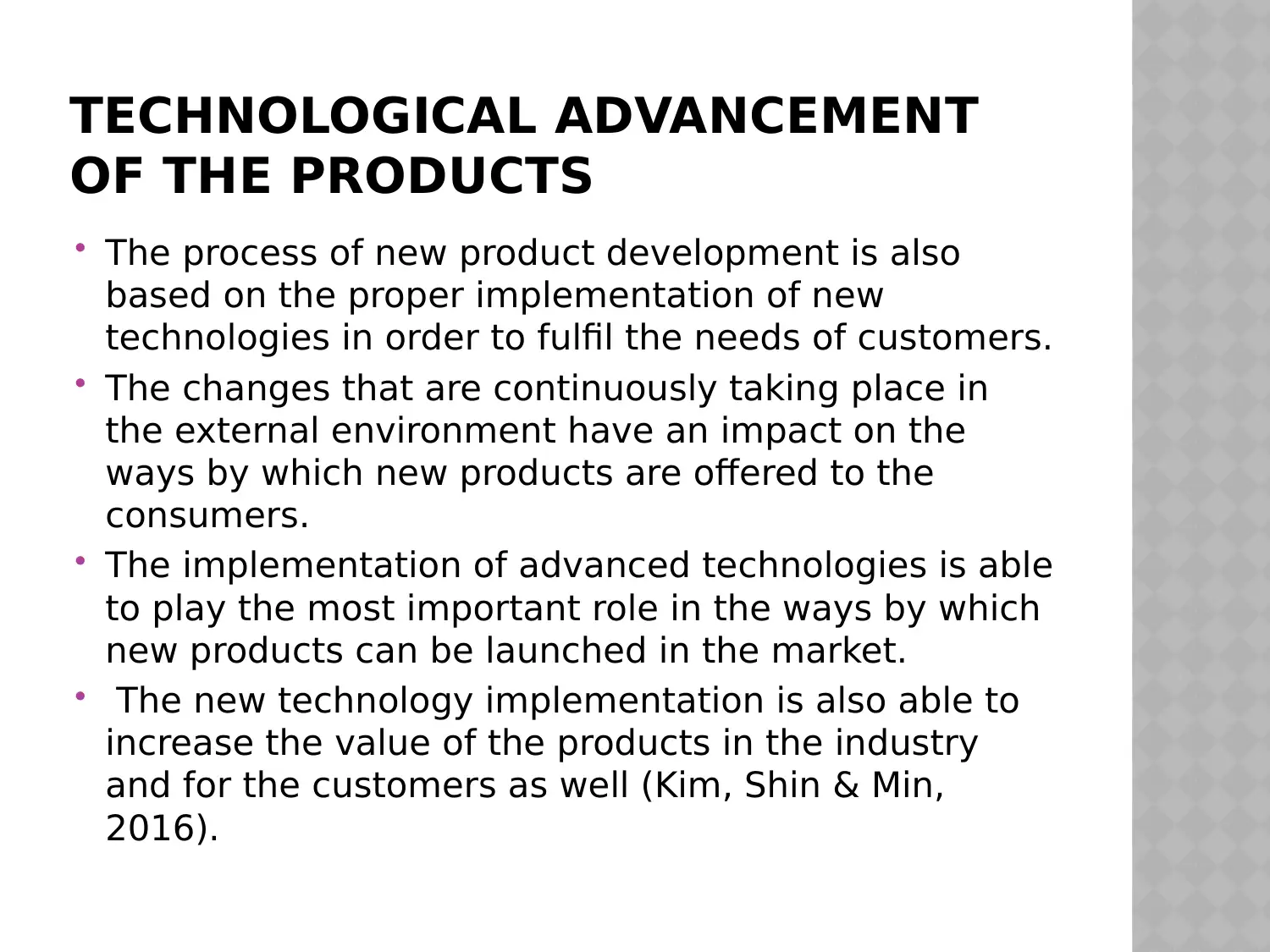
TECHNOLOGICAL ADVANCEMENT
OF THE PRODUCTS
The process of new product development is also
based on the proper implementation of new
technologies in order to fulfil the needs of customers.
The changes that are continuously taking place in
the external environment have an impact on the
ways by which new products are offered to the
consumers.
The implementation of advanced technologies is able
to play the most important role in the ways by which
new products can be launched in the market.
The new technology implementation is also able to
increase the value of the products in the industry
and for the customers as well (Kim, Shin & Min,
2016).
OF THE PRODUCTS
The process of new product development is also
based on the proper implementation of new
technologies in order to fulfil the needs of customers.
The changes that are continuously taking place in
the external environment have an impact on the
ways by which new products are offered to the
consumers.
The implementation of advanced technologies is able
to play the most important role in the ways by which
new products can be launched in the market.
The new technology implementation is also able to
increase the value of the products in the industry
and for the customers as well (Kim, Shin & Min,
2016).
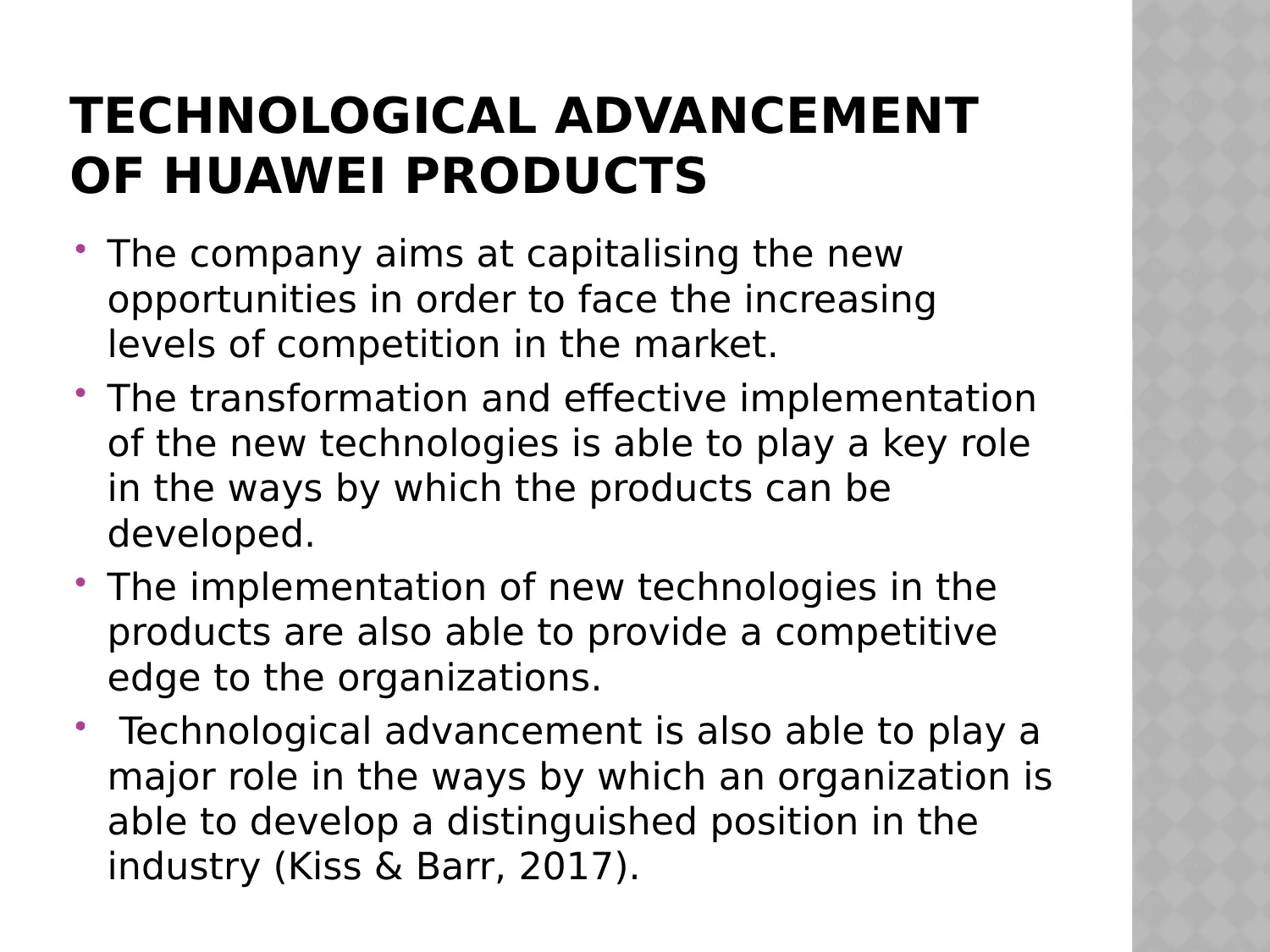
TECHNOLOGICAL ADVANCEMENT
OF HUAWEI PRODUCTS
The company aims at capitalising the new
opportunities in order to face the increasing
levels of competition in the market.
The transformation and effective implementation
of the new technologies is able to play a key role
in the ways by which the products can be
developed.
The implementation of new technologies in the
products are also able to provide a competitive
edge to the organizations.
Technological advancement is also able to play a
major role in the ways by which an organization is
able to develop a distinguished position in the
industry (Kiss & Barr, 2017).
OF HUAWEI PRODUCTS
The company aims at capitalising the new
opportunities in order to face the increasing
levels of competition in the market.
The transformation and effective implementation
of the new technologies is able to play a key role
in the ways by which the products can be
developed.
The implementation of new technologies in the
products are also able to provide a competitive
edge to the organizations.
Technological advancement is also able to play a
major role in the ways by which an organization is
able to develop a distinguished position in the
industry (Kiss & Barr, 2017).
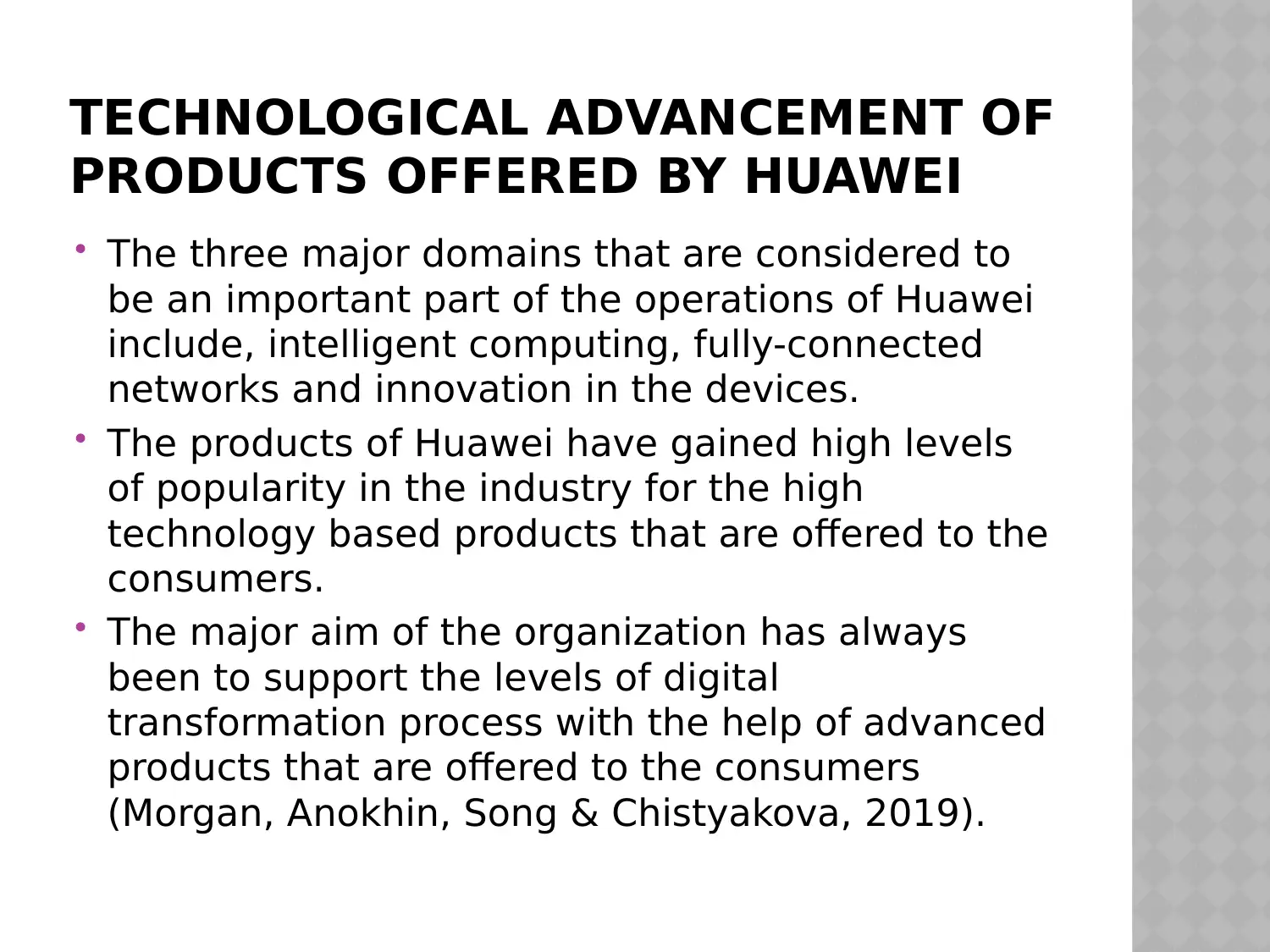
TECHNOLOGICAL ADVANCEMENT OF
PRODUCTS OFFERED BY HUAWEI
The three major domains that are considered to
be an important part of the operations of Huawei
include, intelligent computing, fully-connected
networks and innovation in the devices.
The products of Huawei have gained high levels
of popularity in the industry for the high
technology based products that are offered to the
consumers.
The major aim of the organization has always
been to support the levels of digital
transformation process with the help of advanced
products that are offered to the consumers
(Morgan, Anokhin, Song & Chistyakova, 2019).
PRODUCTS OFFERED BY HUAWEI
The three major domains that are considered to
be an important part of the operations of Huawei
include, intelligent computing, fully-connected
networks and innovation in the devices.
The products of Huawei have gained high levels
of popularity in the industry for the high
technology based products that are offered to the
consumers.
The major aim of the organization has always
been to support the levels of digital
transformation process with the help of advanced
products that are offered to the consumers
(Morgan, Anokhin, Song & Chistyakova, 2019).
Paraphrase This Document
Need a fresh take? Get an instant paraphrase of this document with our AI Paraphraser
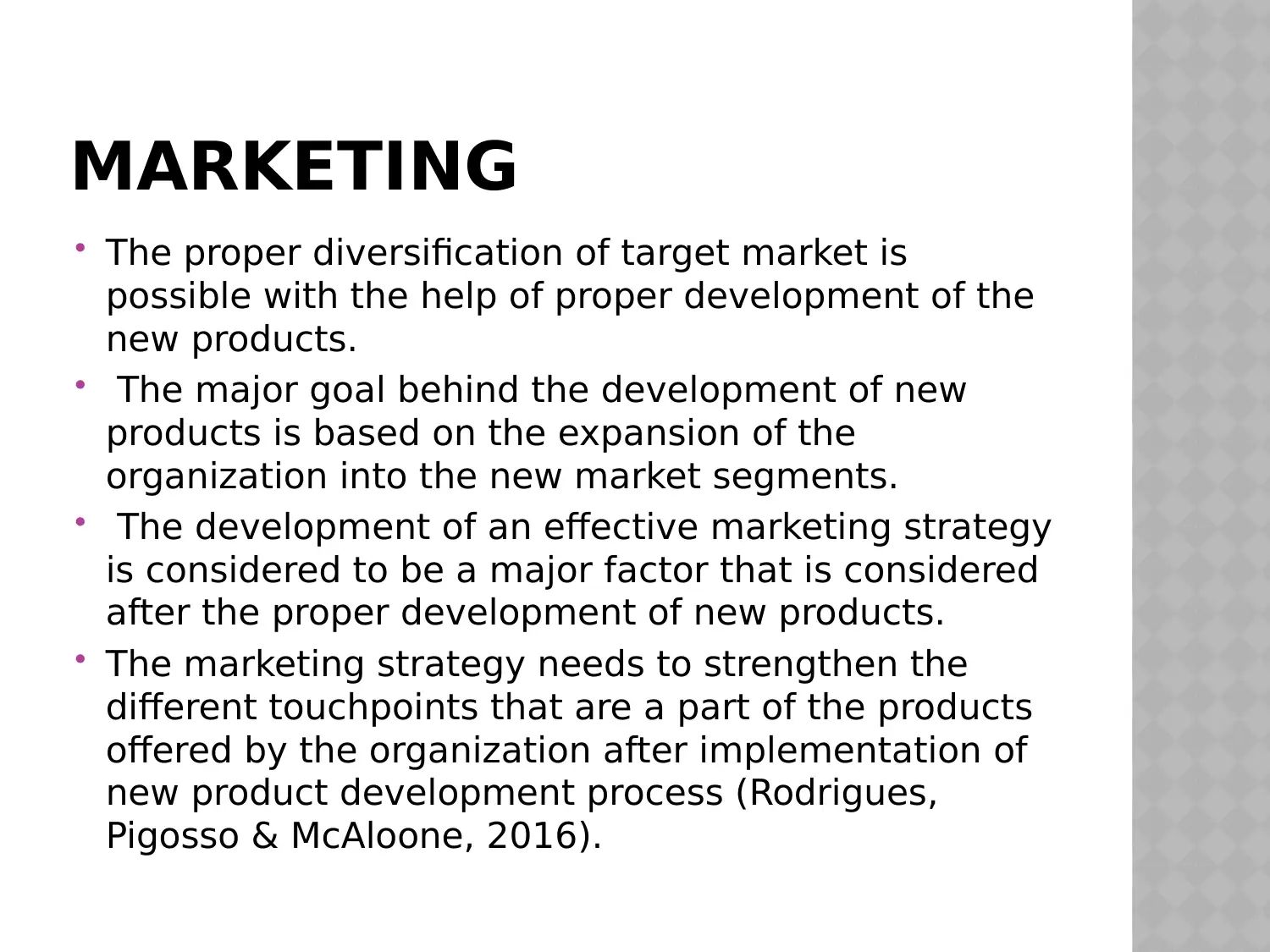
MARKETING
The proper diversification of target market is
possible with the help of proper development of the
new products.
The major goal behind the development of new
products is based on the expansion of the
organization into the new market segments.
The development of an effective marketing strategy
is considered to be a major factor that is considered
after the proper development of new products.
The marketing strategy needs to strengthen the
different touchpoints that are a part of the products
offered by the organization after implementation of
new product development process (Rodrigues,
Pigosso & McAloone, 2016).
The proper diversification of target market is
possible with the help of proper development of the
new products.
The major goal behind the development of new
products is based on the expansion of the
organization into the new market segments.
The development of an effective marketing strategy
is considered to be a major factor that is considered
after the proper development of new products.
The marketing strategy needs to strengthen the
different touchpoints that are a part of the products
offered by the organization after implementation of
new product development process (Rodrigues,
Pigosso & McAloone, 2016).
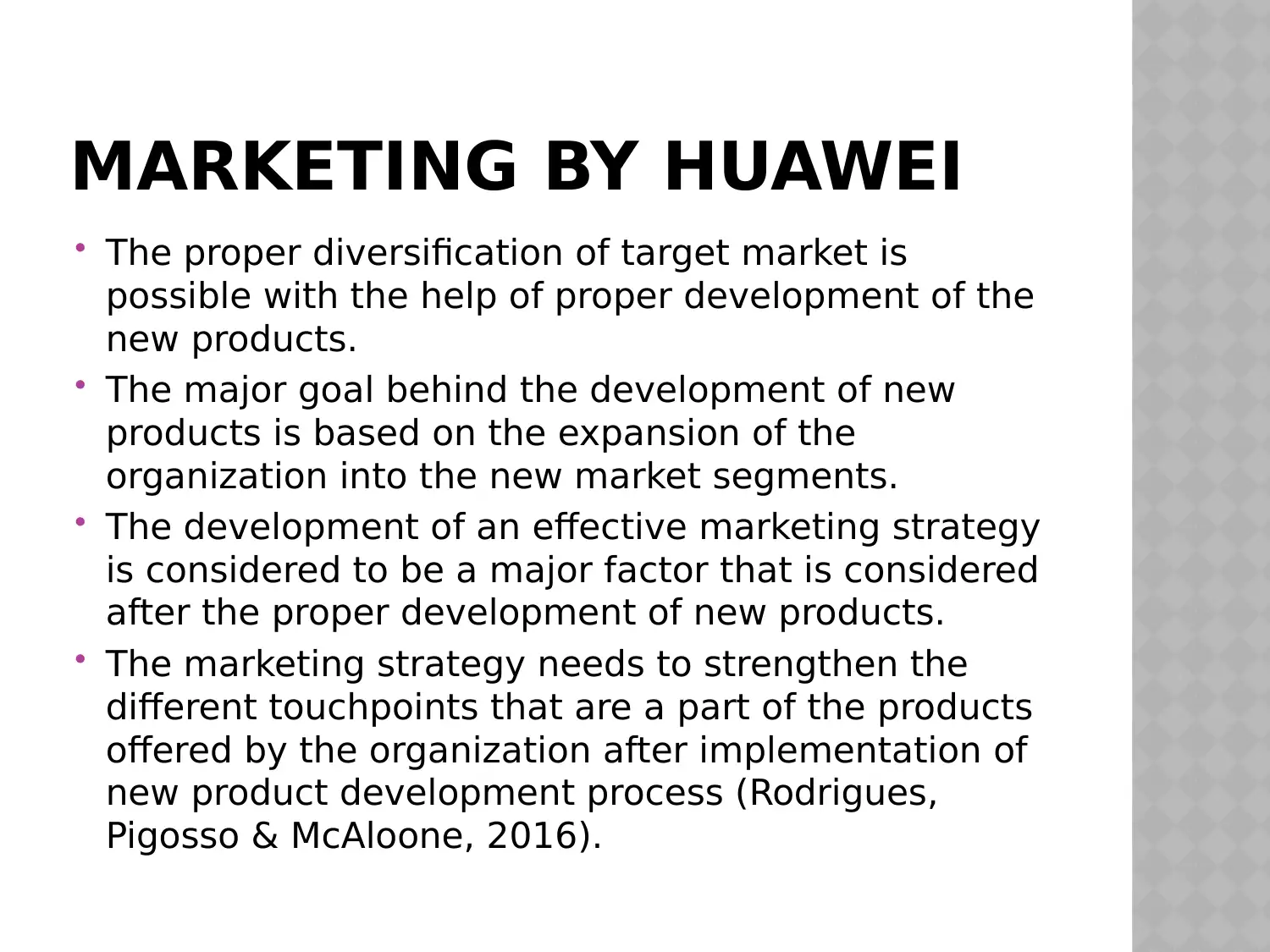
MARKETING BY HUAWEI
The proper diversification of target market is
possible with the help of proper development of the
new products.
The major goal behind the development of new
products is based on the expansion of the
organization into the new market segments.
The development of an effective marketing strategy
is considered to be a major factor that is considered
after the proper development of new products.
The marketing strategy needs to strengthen the
different touchpoints that are a part of the products
offered by the organization after implementation of
new product development process (Rodrigues,
Pigosso & McAloone, 2016).
The proper diversification of target market is
possible with the help of proper development of the
new products.
The major goal behind the development of new
products is based on the expansion of the
organization into the new market segments.
The development of an effective marketing strategy
is considered to be a major factor that is considered
after the proper development of new products.
The marketing strategy needs to strengthen the
different touchpoints that are a part of the products
offered by the organization after implementation of
new product development process (Rodrigues,
Pigosso & McAloone, 2016).
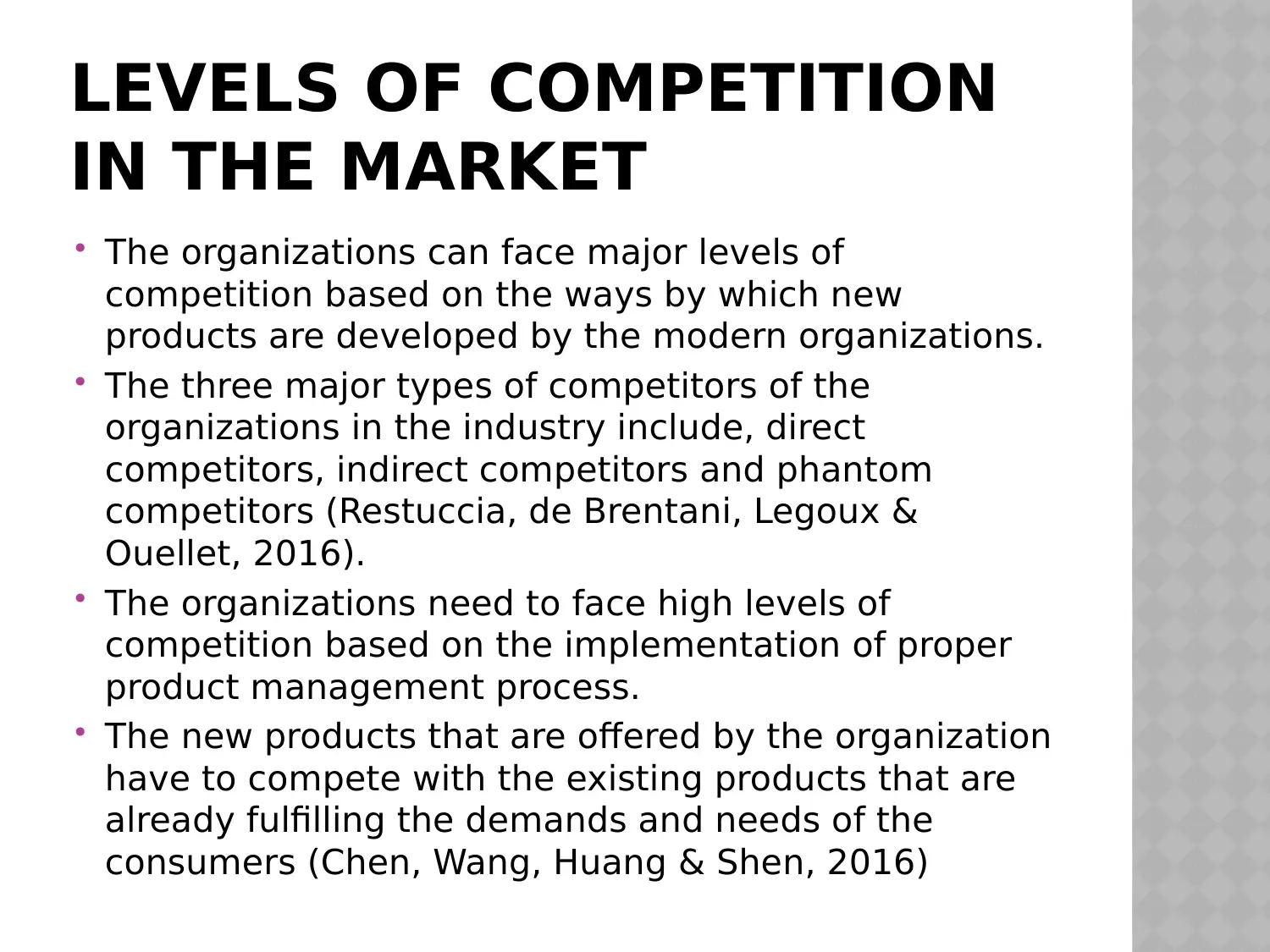
LEVELS OF COMPETITION
IN THE MARKET
The organizations can face major levels of
competition based on the ways by which new
products are developed by the modern organizations.
The three major types of competitors of the
organizations in the industry include, direct
competitors, indirect competitors and phantom
competitors (Restuccia, de Brentani, Legoux &
Ouellet, 2016).
The organizations need to face high levels of
competition based on the implementation of proper
product management process.
The new products that are offered by the organization
have to compete with the existing products that are
already fulfilling the demands and needs of the
consumers (Chen, Wang, Huang & Shen, 2016)
IN THE MARKET
The organizations can face major levels of
competition based on the ways by which new
products are developed by the modern organizations.
The three major types of competitors of the
organizations in the industry include, direct
competitors, indirect competitors and phantom
competitors (Restuccia, de Brentani, Legoux &
Ouellet, 2016).
The organizations need to face high levels of
competition based on the implementation of proper
product management process.
The new products that are offered by the organization
have to compete with the existing products that are
already fulfilling the demands and needs of the
consumers (Chen, Wang, Huang & Shen, 2016)
Secure Best Marks with AI Grader
Need help grading? Try our AI Grader for instant feedback on your assignments.
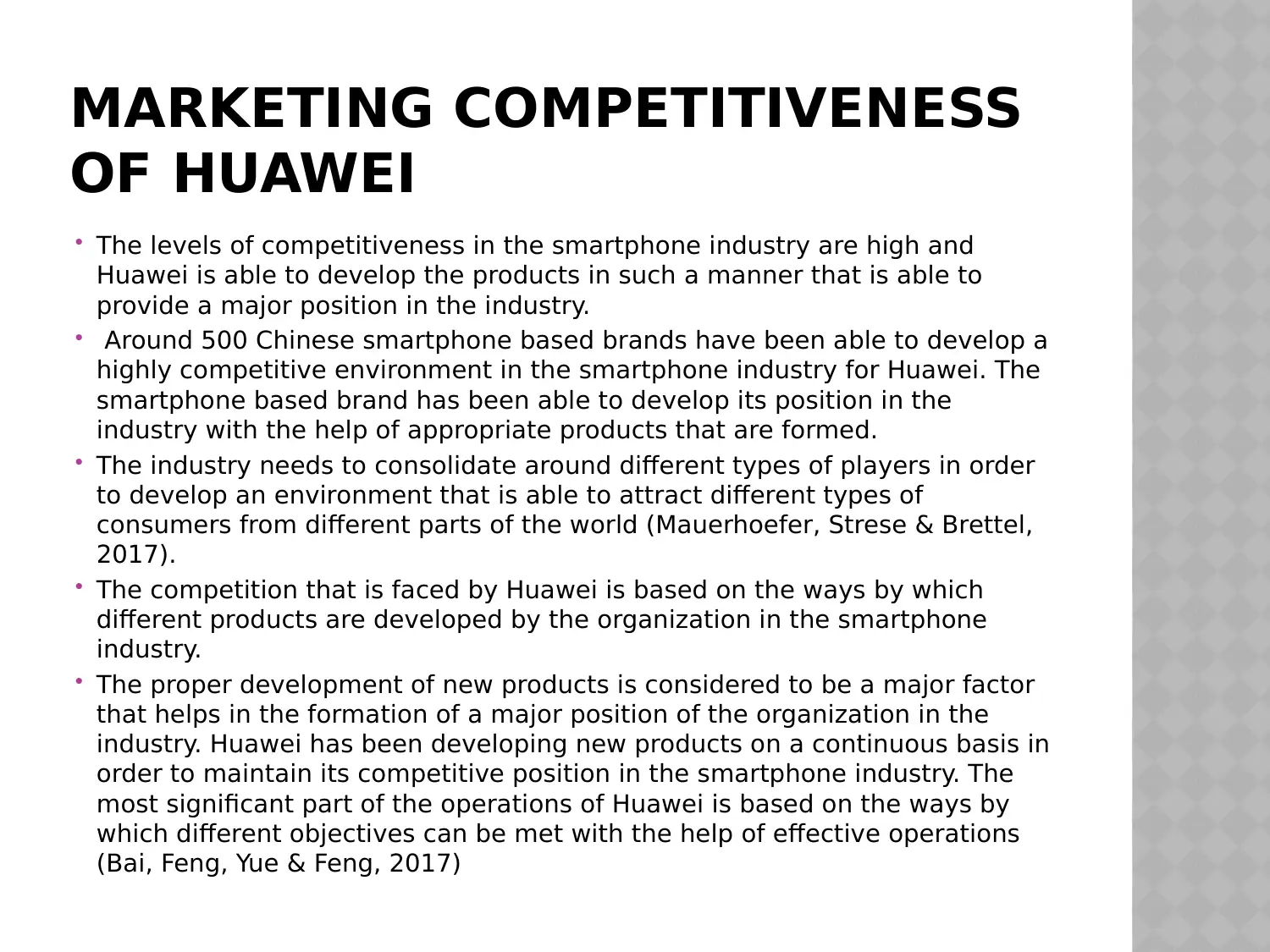
MARKETING COMPETITIVENESS
OF HUAWEI
The levels of competitiveness in the smartphone industry are high and
Huawei is able to develop the products in such a manner that is able to
provide a major position in the industry.
Around 500 Chinese smartphone based brands have been able to develop a
highly competitive environment in the smartphone industry for Huawei. The
smartphone based brand has been able to develop its position in the
industry with the help of appropriate products that are formed.
The industry needs to consolidate around different types of players in order
to develop an environment that is able to attract different types of
consumers from different parts of the world (Mauerhoefer, Strese & Brettel,
2017).
The competition that is faced by Huawei is based on the ways by which
different products are developed by the organization in the smartphone
industry.
The proper development of new products is considered to be a major factor
that helps in the formation of a major position of the organization in the
industry. Huawei has been developing new products on a continuous basis in
order to maintain its competitive position in the smartphone industry. The
most significant part of the operations of Huawei is based on the ways by
which different objectives can be met with the help of effective operations
(Bai, Feng, Yue & Feng, 2017)
OF HUAWEI
The levels of competitiveness in the smartphone industry are high and
Huawei is able to develop the products in such a manner that is able to
provide a major position in the industry.
Around 500 Chinese smartphone based brands have been able to develop a
highly competitive environment in the smartphone industry for Huawei. The
smartphone based brand has been able to develop its position in the
industry with the help of appropriate products that are formed.
The industry needs to consolidate around different types of players in order
to develop an environment that is able to attract different types of
consumers from different parts of the world (Mauerhoefer, Strese & Brettel,
2017).
The competition that is faced by Huawei is based on the ways by which
different products are developed by the organization in the smartphone
industry.
The proper development of new products is considered to be a major factor
that helps in the formation of a major position of the organization in the
industry. Huawei has been developing new products on a continuous basis in
order to maintain its competitive position in the smartphone industry. The
most significant part of the operations of Huawei is based on the ways by
which different objectives can be met with the help of effective operations
(Bai, Feng, Yue & Feng, 2017)
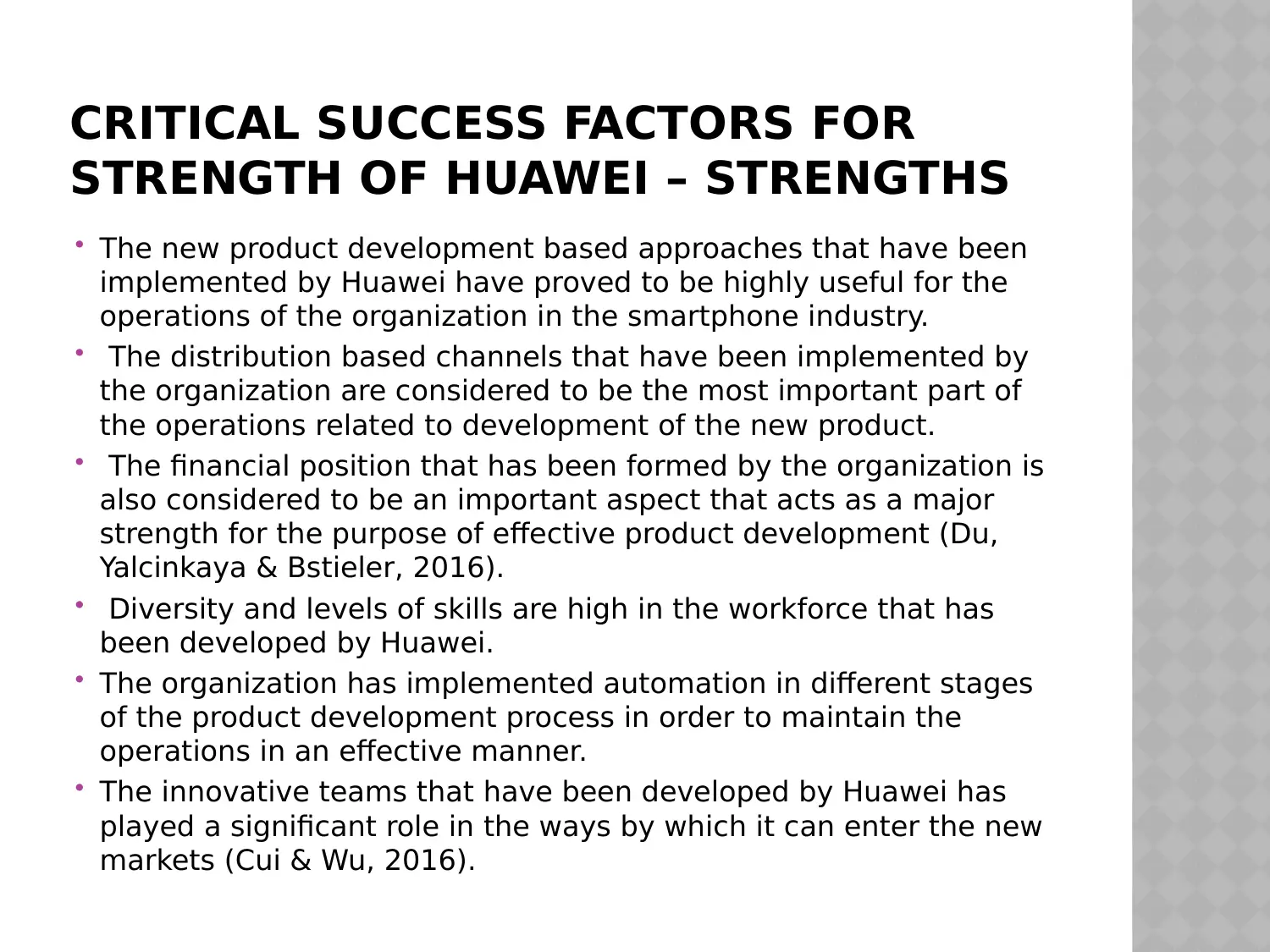
CRITICAL SUCCESS FACTORS FOR
STRENGTH OF HUAWEI – STRENGTHS
The new product development based approaches that have been
implemented by Huawei have proved to be highly useful for the
operations of the organization in the smartphone industry.
The distribution based channels that have been implemented by
the organization are considered to be the most important part of
the operations related to development of the new product.
The financial position that has been formed by the organization is
also considered to be an important aspect that acts as a major
strength for the purpose of effective product development (Du,
Yalcinkaya & Bstieler, 2016).
Diversity and levels of skills are high in the workforce that has
been developed by Huawei.
The organization has implemented automation in different stages
of the product development process in order to maintain the
operations in an effective manner.
The innovative teams that have been developed by Huawei has
played a significant role in the ways by which it can enter the new
markets (Cui & Wu, 2016).
STRENGTH OF HUAWEI – STRENGTHS
The new product development based approaches that have been
implemented by Huawei have proved to be highly useful for the
operations of the organization in the smartphone industry.
The distribution based channels that have been implemented by
the organization are considered to be the most important part of
the operations related to development of the new product.
The financial position that has been formed by the organization is
also considered to be an important aspect that acts as a major
strength for the purpose of effective product development (Du,
Yalcinkaya & Bstieler, 2016).
Diversity and levels of skills are high in the workforce that has
been developed by Huawei.
The organization has implemented automation in different stages
of the product development process in order to maintain the
operations in an effective manner.
The innovative teams that have been developed by Huawei has
played a significant role in the ways by which it can enter the new
markets (Cui & Wu, 2016).
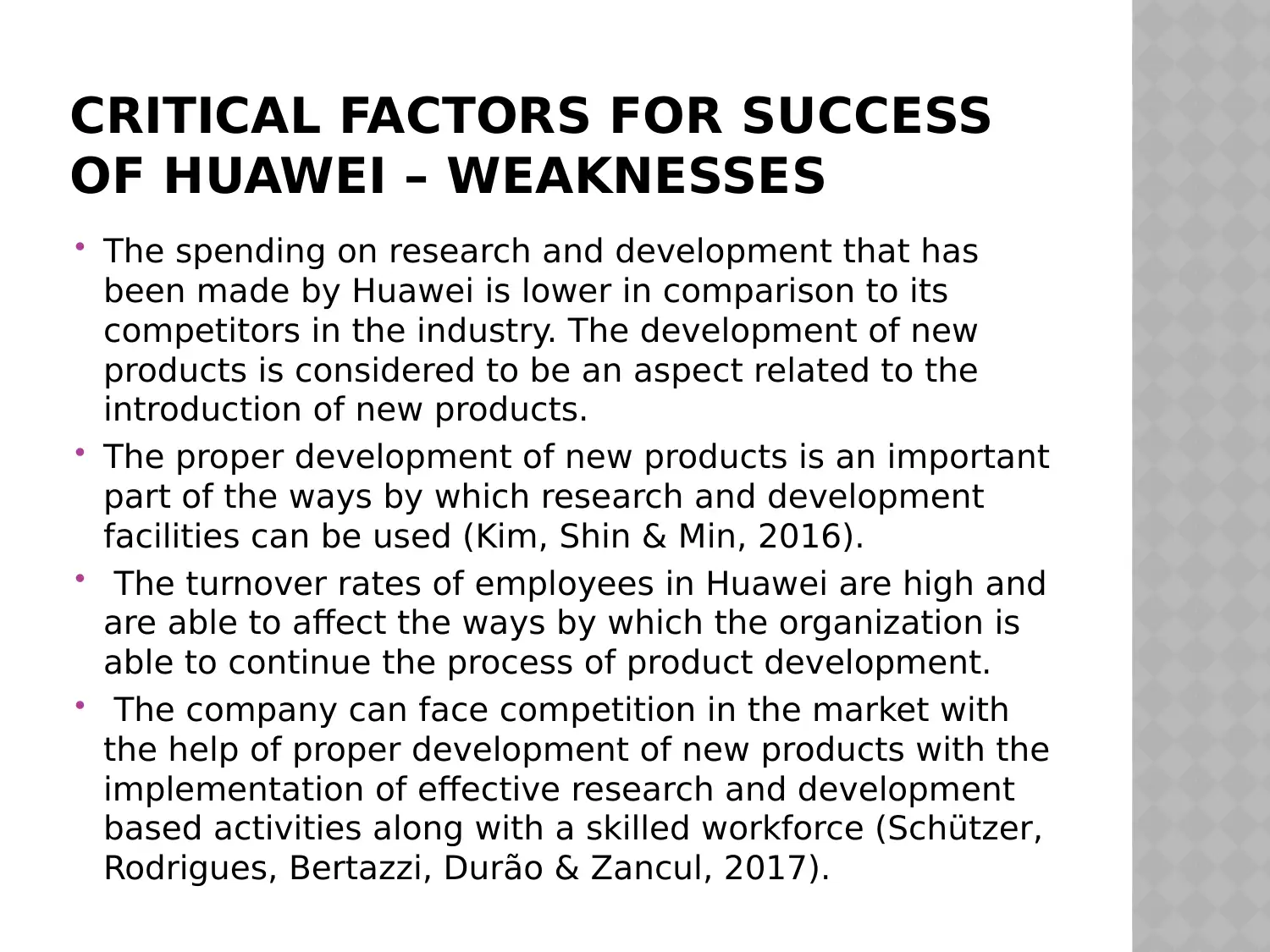
CRITICAL FACTORS FOR SUCCESS
OF HUAWEI – WEAKNESSES
The spending on research and development that has
been made by Huawei is lower in comparison to its
competitors in the industry. The development of new
products is considered to be an aspect related to the
introduction of new products.
The proper development of new products is an important
part of the ways by which research and development
facilities can be used (Kim, Shin & Min, 2016).
The turnover rates of employees in Huawei are high and
are able to affect the ways by which the organization is
able to continue the process of product development.
The company can face competition in the market with
the help of proper development of new products with the
implementation of effective research and development
based activities along with a skilled workforce (Schützer,
Rodrigues, Bertazzi, Durão & Zancul, 2017).
OF HUAWEI – WEAKNESSES
The spending on research and development that has
been made by Huawei is lower in comparison to its
competitors in the industry. The development of new
products is considered to be an aspect related to the
introduction of new products.
The proper development of new products is an important
part of the ways by which research and development
facilities can be used (Kim, Shin & Min, 2016).
The turnover rates of employees in Huawei are high and
are able to affect the ways by which the organization is
able to continue the process of product development.
The company can face competition in the market with
the help of proper development of new products with the
implementation of effective research and development
based activities along with a skilled workforce (Schützer,
Rodrigues, Bertazzi, Durão & Zancul, 2017).
Paraphrase This Document
Need a fresh take? Get an instant paraphrase of this document with our AI Paraphraser
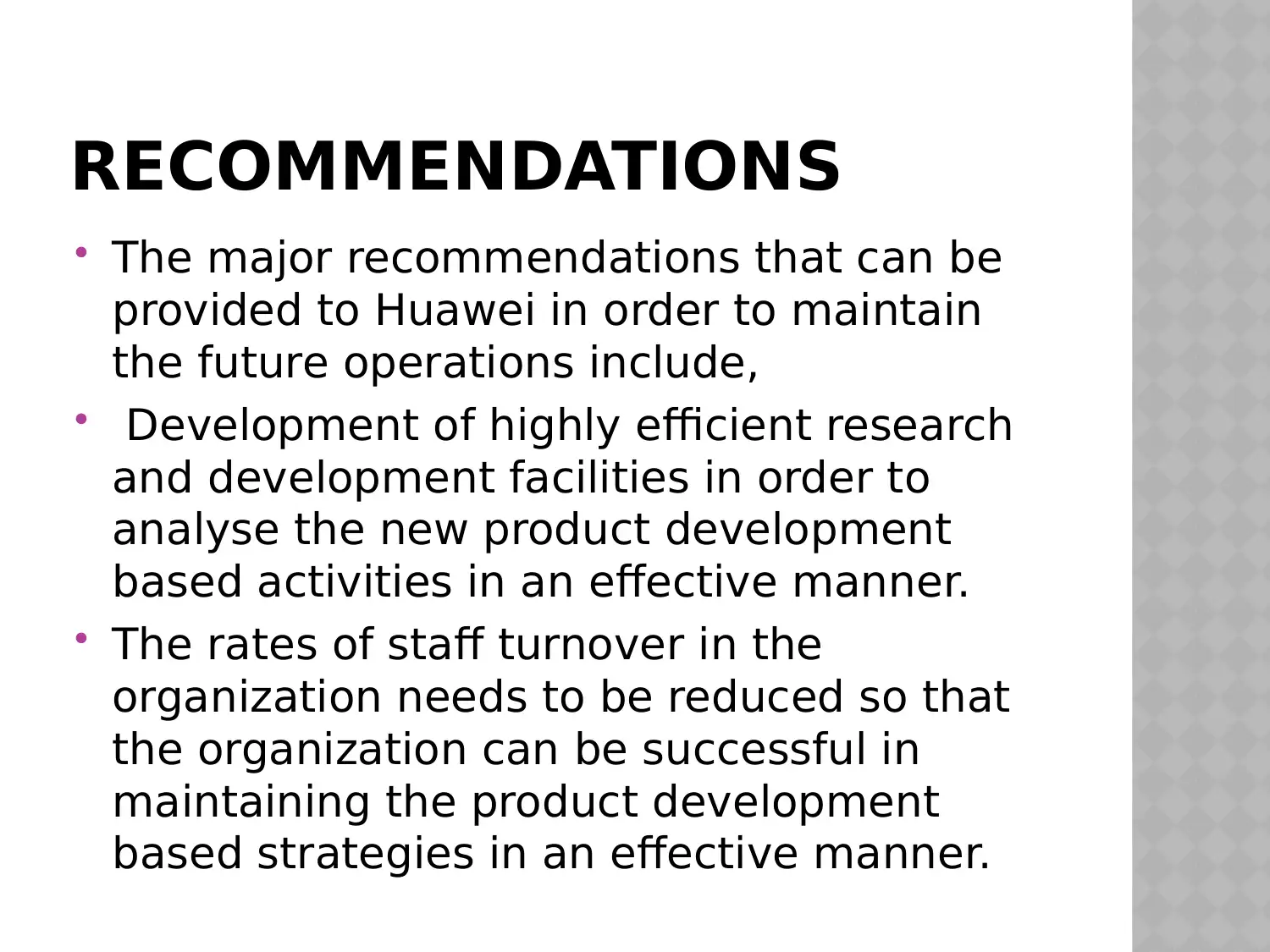
RECOMMENDATIONS
The major recommendations that can be
provided to Huawei in order to maintain
the future operations include,
Development of highly efficient research
and development facilities in order to
analyse the new product development
based activities in an effective manner.
The rates of staff turnover in the
organization needs to be reduced so that
the organization can be successful in
maintaining the product development
based strategies in an effective manner.
The major recommendations that can be
provided to Huawei in order to maintain
the future operations include,
Development of highly efficient research
and development facilities in order to
analyse the new product development
based activities in an effective manner.
The rates of staff turnover in the
organization needs to be reduced so that
the organization can be successful in
maintaining the product development
based strategies in an effective manner.
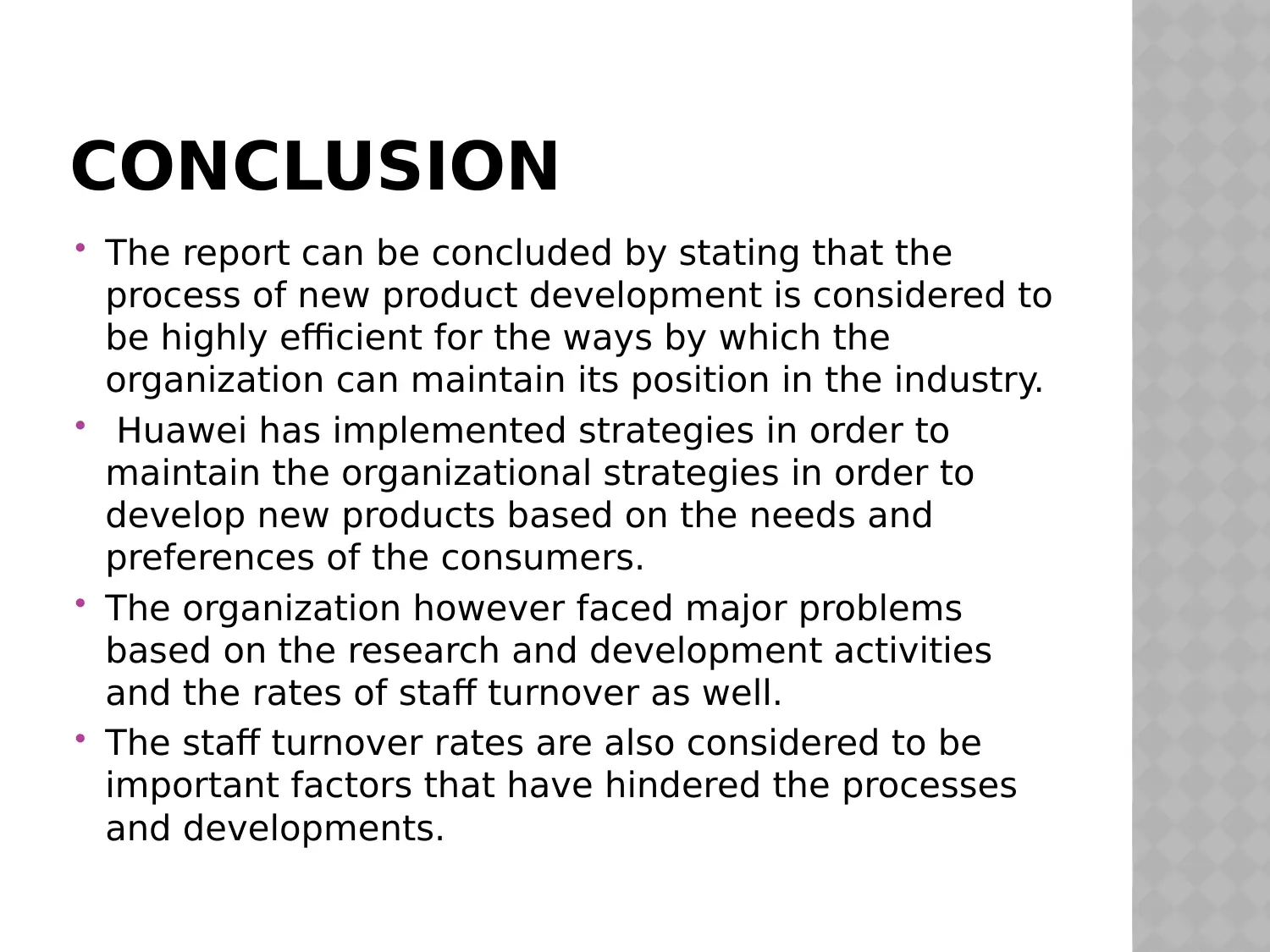
CONCLUSION
The report can be concluded by stating that the
process of new product development is considered to
be highly efficient for the ways by which the
organization can maintain its position in the industry.
Huawei has implemented strategies in order to
maintain the organizational strategies in order to
develop new products based on the needs and
preferences of the consumers.
The organization however faced major problems
based on the research and development activities
and the rates of staff turnover as well.
The staff turnover rates are also considered to be
important factors that have hindered the processes
and developments.
The report can be concluded by stating that the
process of new product development is considered to
be highly efficient for the ways by which the
organization can maintain its position in the industry.
Huawei has implemented strategies in order to
maintain the organizational strategies in order to
develop new products based on the needs and
preferences of the consumers.
The organization however faced major problems
based on the research and development activities
and the rates of staff turnover as well.
The staff turnover rates are also considered to be
important factors that have hindered the processes
and developments.
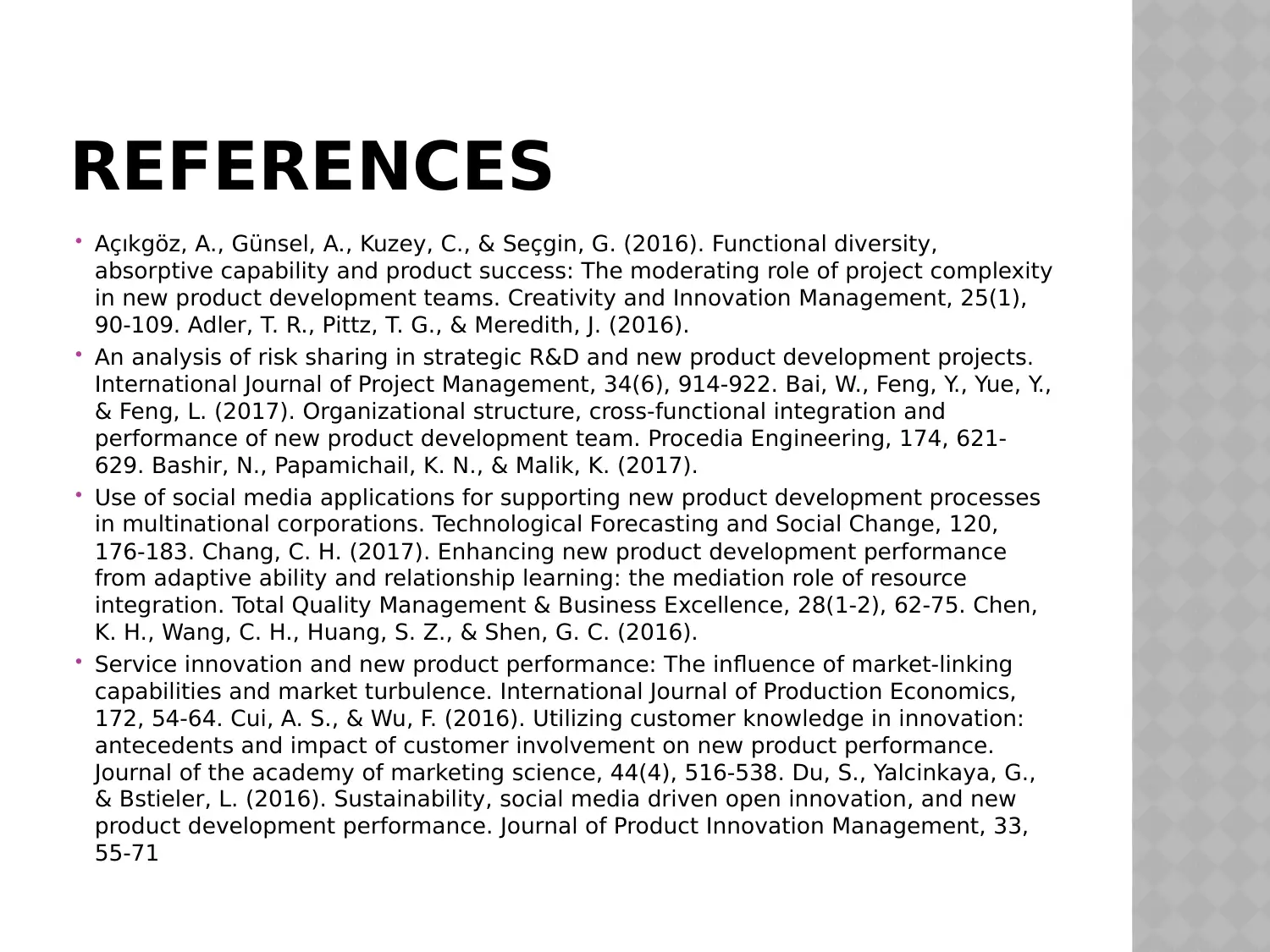
REFERENCES
Açıkgöz, A., Günsel, A., Kuzey, C., & Seçgin, G. (2016). Functional diversity,
absorptive capability and product success: The moderating role of project complexity
in new product development teams. Creativity and Innovation Management, 25(1),
90-109. Adler, T. R., Pittz, T. G., & Meredith, J. (2016).
An analysis of risk sharing in strategic R&D and new product development projects.
International Journal of Project Management, 34(6), 914-922. Bai, W., Feng, Y., Yue, Y.,
& Feng, L. (2017). Organizational structure, cross-functional integration and
performance of new product development team. Procedia Engineering, 174, 621-
629. Bashir, N., Papamichail, K. N., & Malik, K. (2017).
Use of social media applications for supporting new product development processes
in multinational corporations. Technological Forecasting and Social Change, 120,
176-183. Chang, C. H. (2017). Enhancing new product development performance
from adaptive ability and relationship learning: the mediation role of resource
integration. Total Quality Management & Business Excellence, 28(1-2), 62-75. Chen,
K. H., Wang, C. H., Huang, S. Z., & Shen, G. C. (2016).
Service innovation and new product performance: The influence of market-linking
capabilities and market turbulence. International Journal of Production Economics,
172, 54-64. Cui, A. S., & Wu, F. (2016). Utilizing customer knowledge in innovation:
antecedents and impact of customer involvement on new product performance.
Journal of the academy of marketing science, 44(4), 516-538. Du, S., Yalcinkaya, G.,
& Bstieler, L. (2016). Sustainability, social media driven open innovation, and new
product development performance. Journal of Product Innovation Management, 33,
55-71
Açıkgöz, A., Günsel, A., Kuzey, C., & Seçgin, G. (2016). Functional diversity,
absorptive capability and product success: The moderating role of project complexity
in new product development teams. Creativity and Innovation Management, 25(1),
90-109. Adler, T. R., Pittz, T. G., & Meredith, J. (2016).
An analysis of risk sharing in strategic R&D and new product development projects.
International Journal of Project Management, 34(6), 914-922. Bai, W., Feng, Y., Yue, Y.,
& Feng, L. (2017). Organizational structure, cross-functional integration and
performance of new product development team. Procedia Engineering, 174, 621-
629. Bashir, N., Papamichail, K. N., & Malik, K. (2017).
Use of social media applications for supporting new product development processes
in multinational corporations. Technological Forecasting and Social Change, 120,
176-183. Chang, C. H. (2017). Enhancing new product development performance
from adaptive ability and relationship learning: the mediation role of resource
integration. Total Quality Management & Business Excellence, 28(1-2), 62-75. Chen,
K. H., Wang, C. H., Huang, S. Z., & Shen, G. C. (2016).
Service innovation and new product performance: The influence of market-linking
capabilities and market turbulence. International Journal of Production Economics,
172, 54-64. Cui, A. S., & Wu, F. (2016). Utilizing customer knowledge in innovation:
antecedents and impact of customer involvement on new product performance.
Journal of the academy of marketing science, 44(4), 516-538. Du, S., Yalcinkaya, G.,
& Bstieler, L. (2016). Sustainability, social media driven open innovation, and new
product development performance. Journal of Product Innovation Management, 33,
55-71
Secure Best Marks with AI Grader
Need help grading? Try our AI Grader for instant feedback on your assignments.
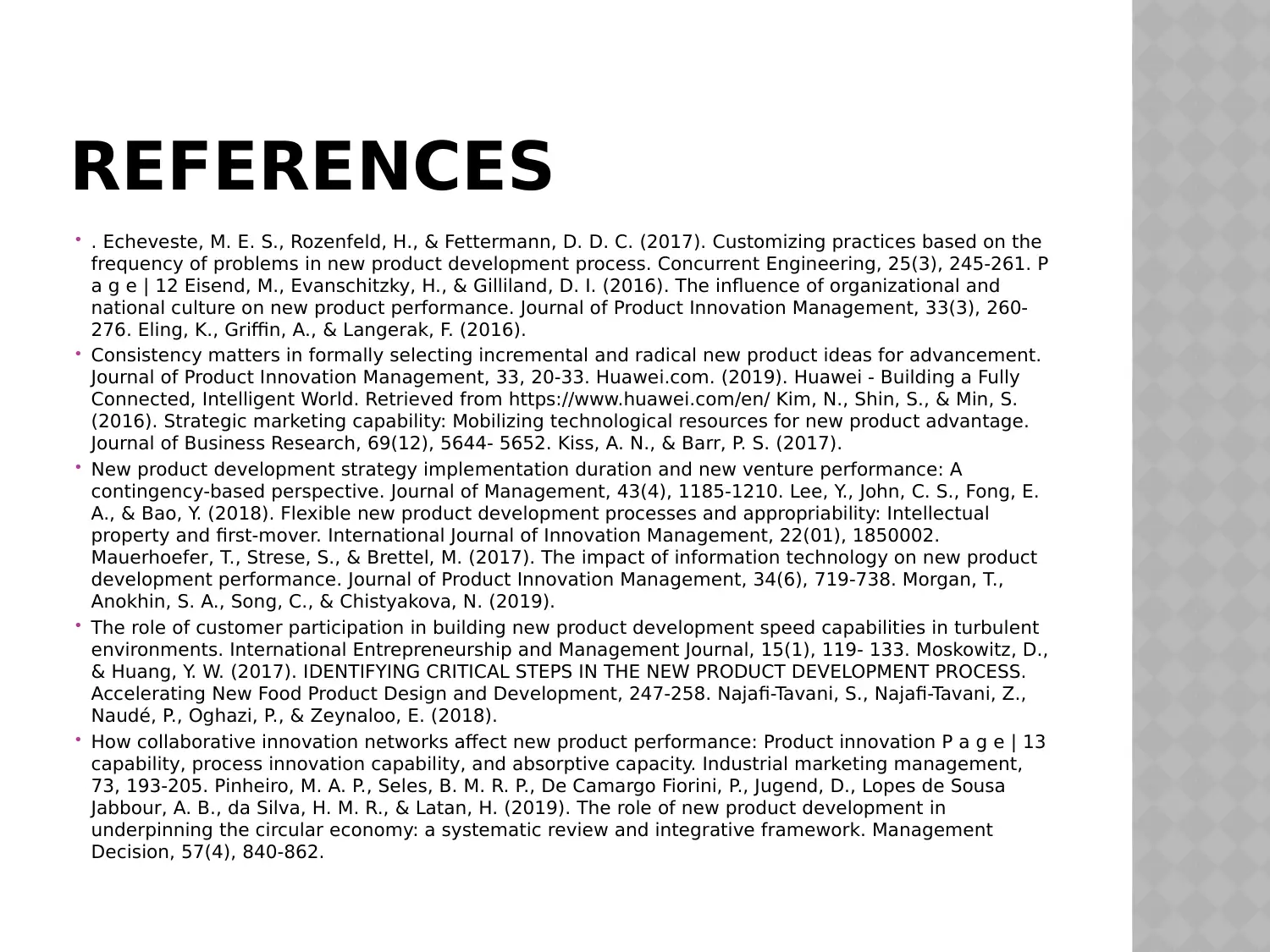
REFERENCES
. Echeveste, M. E. S., Rozenfeld, H., & Fettermann, D. D. C. (2017). Customizing practices based on the
frequency of problems in new product development process. Concurrent Engineering, 25(3), 245-261. P
a g e | 12 Eisend, M., Evanschitzky, H., & Gilliland, D. I. (2016). The influence of organizational and
national culture on new product performance. Journal of Product Innovation Management, 33(3), 260-
276. Eling, K., Griffin, A., & Langerak, F. (2016).
Consistency matters in formally selecting incremental and radical new product ideas for advancement.
Journal of Product Innovation Management, 33, 20-33. Huawei.com. (2019). Huawei - Building a Fully
Connected, Intelligent World. Retrieved from https://www.huawei.com/en/ Kim, N., Shin, S., & Min, S.
(2016). Strategic marketing capability: Mobilizing technological resources for new product advantage.
Journal of Business Research, 69(12), 5644- 5652. Kiss, A. N., & Barr, P. S. (2017).
New product development strategy implementation duration and new venture performance: A
contingency-based perspective. Journal of Management, 43(4), 1185-1210. Lee, Y., John, C. S., Fong, E.
A., & Bao, Y. (2018). Flexible new product development processes and appropriability: Intellectual
property and first-mover. International Journal of Innovation Management, 22(01), 1850002.
Mauerhoefer, T., Strese, S., & Brettel, M. (2017). The impact of information technology on new product
development performance. Journal of Product Innovation Management, 34(6), 719-738. Morgan, T.,
Anokhin, S. A., Song, C., & Chistyakova, N. (2019).
The role of customer participation in building new product development speed capabilities in turbulent
environments. International Entrepreneurship and Management Journal, 15(1), 119- 133. Moskowitz, D.,
& Huang, Y. W. (2017). IDENTIFYING CRITICAL STEPS IN THE NEW PRODUCT DEVELOPMENT PROCESS.
Accelerating New Food Product Design and Development, 247-258. Najafi-Tavani, S., Najafi-Tavani, Z.,
Naudé, P., Oghazi, P., & Zeynaloo, E. (2018).
How collaborative innovation networks affect new product performance: Product innovation P a g e | 13
capability, process innovation capability, and absorptive capacity. Industrial marketing management,
73, 193-205. Pinheiro, M. A. P., Seles, B. M. R. P., De Camargo Fiorini, P., Jugend, D., Lopes de Sousa
Jabbour, A. B., da Silva, H. M. R., & Latan, H. (2019). The role of new product development in
underpinning the circular economy: a systematic review and integrative framework. Management
Decision, 57(4), 840-862.
. Echeveste, M. E. S., Rozenfeld, H., & Fettermann, D. D. C. (2017). Customizing practices based on the
frequency of problems in new product development process. Concurrent Engineering, 25(3), 245-261. P
a g e | 12 Eisend, M., Evanschitzky, H., & Gilliland, D. I. (2016). The influence of organizational and
national culture on new product performance. Journal of Product Innovation Management, 33(3), 260-
276. Eling, K., Griffin, A., & Langerak, F. (2016).
Consistency matters in formally selecting incremental and radical new product ideas for advancement.
Journal of Product Innovation Management, 33, 20-33. Huawei.com. (2019). Huawei - Building a Fully
Connected, Intelligent World. Retrieved from https://www.huawei.com/en/ Kim, N., Shin, S., & Min, S.
(2016). Strategic marketing capability: Mobilizing technological resources for new product advantage.
Journal of Business Research, 69(12), 5644- 5652. Kiss, A. N., & Barr, P. S. (2017).
New product development strategy implementation duration and new venture performance: A
contingency-based perspective. Journal of Management, 43(4), 1185-1210. Lee, Y., John, C. S., Fong, E.
A., & Bao, Y. (2018). Flexible new product development processes and appropriability: Intellectual
property and first-mover. International Journal of Innovation Management, 22(01), 1850002.
Mauerhoefer, T., Strese, S., & Brettel, M. (2017). The impact of information technology on new product
development performance. Journal of Product Innovation Management, 34(6), 719-738. Morgan, T.,
Anokhin, S. A., Song, C., & Chistyakova, N. (2019).
The role of customer participation in building new product development speed capabilities in turbulent
environments. International Entrepreneurship and Management Journal, 15(1), 119- 133. Moskowitz, D.,
& Huang, Y. W. (2017). IDENTIFYING CRITICAL STEPS IN THE NEW PRODUCT DEVELOPMENT PROCESS.
Accelerating New Food Product Design and Development, 247-258. Najafi-Tavani, S., Najafi-Tavani, Z.,
Naudé, P., Oghazi, P., & Zeynaloo, E. (2018).
How collaborative innovation networks affect new product performance: Product innovation P a g e | 13
capability, process innovation capability, and absorptive capacity. Industrial marketing management,
73, 193-205. Pinheiro, M. A. P., Seles, B. M. R. P., De Camargo Fiorini, P., Jugend, D., Lopes de Sousa
Jabbour, A. B., da Silva, H. M. R., & Latan, H. (2019). The role of new product development in
underpinning the circular economy: a systematic review and integrative framework. Management
Decision, 57(4), 840-862.
1 out of 17
Related Documents
Your All-in-One AI-Powered Toolkit for Academic Success.
+13062052269
info@desklib.com
Available 24*7 on WhatsApp / Email
![[object Object]](/_next/static/media/star-bottom.7253800d.svg)
Unlock your academic potential
© 2024 | Zucol Services PVT LTD | All rights reserved.





